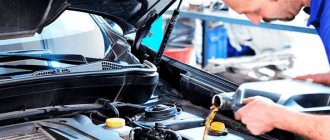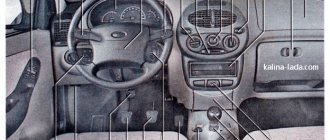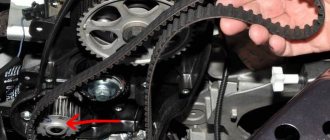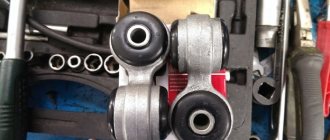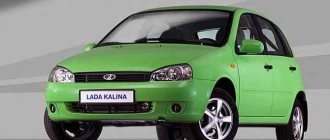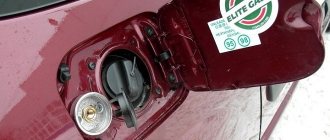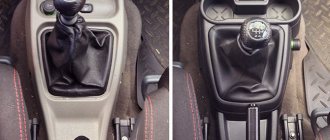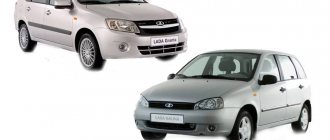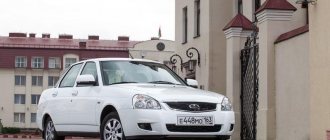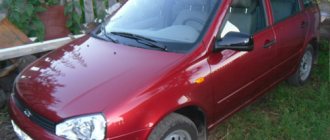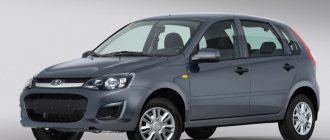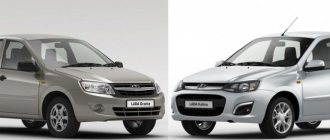Lada Kalina is the brainchild of the famous Russian automobile. In appearance, the car is small in size, but after you get into the cabin, you will be amazed by the amount of free space in the cabin. Cars of this family began to be produced on November 18, 2004. The manufacturing plant began developing the car back in 1993, and received its name Lada Kalina 5 years later.
At first, the car was produced with a sedan body (VAZ-1118), about two years later the assembly of the VAZ Kalina hatchback (VAZ-1119) began, and in the summer of 2007 the first car with a station wagon (VAZ-1117) rolled off the assembly line.
Technological features of Lada Kalina
Cars of the Lada Kalina family are equipped with fairly powerful power units, which are equipped with an ignition system and electronic fuel injection control. At the same time, the motor fully meets European safety and environmental standards.
Lada Kalina cars, compared to other Russian cars, have a high degree of maneuverability. In addition, they boast compact sizes. The combination of small dimensions and maneuverability is a good option for moving around a big city. The entire model range is equipped with a rack-and-pinion steering mechanism and power steering.
Specifications
LADA-1118 Lada Kalina (sedan)
| Modifications with engine | 1.6 l. 8th grade (Euro-3) | 1.4 l. 16 classes (Euro-3) | ||
Body | ||||
| Length, mm | 4040 | 4040 | ||
| Width, mm | 1700 | 1700 | ||
| Height, mm | 1500 | 1500 | ||
| Front wheel track, mm | 1430 | 1430 | ||
| Rear wheel track, mm | 1410 | 1410 | ||
| Luggage compartment volume, cubic meters dm. | 400 | 400 | ||
| Weight in running order, kg | 1080 | 1080 | ||
| Gross vehicle weight, kg | 1555 | 1555 | ||
| Wheel formula / drive wheels | 4 x 2 / front | 4 x 2 / front | ||
| Body type / number of doors | sedan / 4 | sedan / 4 | ||
Engine | ||||
| engine's type | injection petrol | injection petrol | ||
| Supply system | distributed injection with electronic control | distributed injection with electronic control | ||
| Engine displacement, cubic meters cm | 1596 | 1390 | ||
| Maximum power, kW/rpm. | 59,5 / 5200 | 65,5 / 5250 | ||
| Maximum torque, Nm at rpm | 120 / 2500-2900 | 127 / 4200-4800 | ||
| Fuel | AI-95 (min) | AI-95 (min) | ||
| Fuel consumption (combined cycle), l/100 km | 7,8 | 7,0 | ||
| Maximum speed, km/h | 160 | 165 | ||
Transmission | ||||
| Transmission | mechanical | mechanical | ||
| Number of gears | 5 forward, 1 reverse | 5 forward, 1 reverse | ||
Other | ||||
| Steering | with electromechanical amplifier | with electromechanical amplifier | ||
| Tires | 175/70R13 80T,82T,H 5Jx13; 175/65R14 82H 5Jx14; 185/60R14 82H 5.5Jx14 | 175/70R13 80T,82T,H 5Jx13; 175/65R14 82H 5Jx14; 185/60R14 82H 5.5Jx14 | ||
| Fuel tank capacity, l | 50 | 50 | ||
Pros and cons of Lada Kalina
Like all car models, the Lada Kalina family has both advantages and disadvantages.
The advantages of the Lada Kalina car include: a spacious interior for its class; a wide variety of trim levels and colors; good maneuverability; rigid body providing a good level of safety; excellent visibility; reasonable price; the long-awaited presence of additional options both in the areas of comfort and handling.
Among the disadvantages of Kalina family cars are: high level of noise in the cabin due to engine operation; knocking in the front suspension when decompressing; excessively noisy gearbox.
Specifications
LADA-1117 Lada Kalina (station wagon)
| Body type | station wagon |
| Number of doors, pcs | 5 |
| Number of seats, persons | 5 |
| Number of seats with rear seats fully folded, persons | 2 |
| Curb weight, kg | 1080 |
| Useful weight, kg | 475 |
| Maximum weight, kg | 1555 |
| Trunk volume, l | 350 |
| Wheelbase, mm | 2470 |
| Ground clearance, mm | 160 |
| Maximum speed, km/h | 160 |
| Acceleration time to 100 km/h, s | 13 |
| ENGINE | |
| engine's type | 11183, gasoline, four-cylinder, in-line, 8-valve |
| Engine volume, l | 1,6 |
| Maximum power, kW/hp | 59,5/80 |
| Maximum torque/at crankshaft speed, N*m/rpm | 120/2500 |
| Fuel consumption, combined cycle, l | 7,8 |
| Fuel | AI-95 |
| Fuel tank volume, l | 50 |
| TRANSMISSION | |
| Transmission | mechanical |
| OTHER | |
| Total weight of the towed trailer, not equipped with brakes, kg | 450 |
| Gross weight of towed trailer equipped with brakes, kg | 900 |
Numbers and awards
In March 2009, cars of the Lada Kalina brand ranked third in terms of sales in Germany among foreign brands.
According to the Association of European Businesses for 2009, Lada Kalina models took fourth place in the ranking of the most purchased models in Russia. For the whole of 2009, 60,746 cars were sold.
And in the first five months of 2011, the model turned out to be the leader in the number of cars sold in Russia (59,249 units).
According to the EuroNCAP crash test, the Lada Kalina received 8.4 points out of 16 possible for ensuring the safety of adults.
Differences between Lada Kalina 2 (VAZ 2192, 2194) and Kalina (VAZ 1117, 1118 and 1119)
Comparing “Kalina 2” with its predecessor should start with history. Cars under the Lada Kalina brand have been produced since 2004. The first to roll off the assembly line were sedan-type cars (VAZ-1118), two years later mass production of hatchbacks (VAZ-1119) was launched, and a year later the “berry” family was replenished with a station wagon (VAZ-1117). In general, Lada Kalina cars turned out to be quite popular and in 2009 they even took fourth place in the ranking of the best-selling cars in Russia.
However, every year the obsolescence of the Lada Kalina became more and more obvious. A replacement was needed, and in 2011 the four-door Kalina gave way on the assembly line to the new budget Lada Granta sedan, built on the same platform. In 2013, successors also appeared for the hatchback and station wagon, while they retained the name Lada Kalina, receiving the prefix “2” to their name.
Considering the external differences of the Lada Kalina 2 , it is better to perceive it not as a new generation car, but as a deep restyling of the original model. The station wagon and hatchback were based on the platform of the first Kalina, albeit supplemented with a number of new technical solutions. As a result, the external differences between the Lada Kalina 2 and older cars are not so striking. Only the front part of the body underwent significant changes, while at the rear there were not very many design innovations. In profile, the car looks just like the original Lada Kalina, except for the new alloy wheels and wide wings. However, even this was enough to significantly improve and modernize the appearance of the car.
Inside, the difference between Kalina 2 and the previous car is much more noticeable. The interior now features a redesigned, more attractive central console and an air conditioning system with automatic fan mode. The Kalina 2 radio has a touch screen, USB and SD connectors, as well as support for video playback. The list of options has expanded significantly, and a driver airbag and ABS are included in the basic package.
However, AvtoVAZ still has work to do. The layout of the cabin cannot be called particularly comfortable, and the lack of adjustment of the steering wheel for reach and height of the driver's seat only aggravates the situation. The chairs themselves are also not very good - their cushion is short, and lateral support is almost not expressed.
The technical characteristics of Kalina 2 have not changed dramatically. Buyers still have access to an eight-valve 1.6-liter engine with an output of 87 horsepower and a modified 16-valve unit of the same volume, which now develops an output of 106 horsepower. 1.4-liter engines are no longer installed on the car, but today you can buy a Kalina 2 with an automatic transmission, previously tested on the Lada Granta. The archaic four-speed Jatco AY-K3 automatic transmission is installed on the Kalina with a 98 horsepower engine, also borrowed from Granta. Despite not the most modern design, the automatic transmission behaves well in urban conditions, and only on the highway its shortcomings begin to appear. In particular, the dynamics at speeds of 80-120 kilometers per hour are quite sluggish, which makes overtaking difficult.
Another important difference between the Lada Kalina 2 and previous cars is the chassis . To a large extent, it is copied from the many times mentioned Lada Granta, but reconfigured in accordance with the features of the Kalina. The changes benefited the model: the car began to respond more clearly to steering turns, including microsteering, directional stability improved and, in general, the car became more pleasant to drive.
When comparing Kalina 2 with its predecessor, one cannot help but mention the prices. The updated Lada Kalina in a hatchback body in the Standard configuration costs 321.5 thousand rubles, while the original Kalina in a similar configuration costs buyers 311.7 thousand rubles (recommended prices).
On this site you will find many instructions (photo reports) on repairs, tuning and modifications not only of the new Kalina, but also of other LADA cars.
Production problems
Unfortunately, the release of the new Kalina was marred by a couple of unpleasant incidents caused by discovered defects.
So, in 2007, a serious problem was identified in the operation of the steering column, which is why it was necessary to recall over 6,000 cars that were produced between December 2005 and January 2006. The repairs were carried out by the Bryansk-Lada company, an AvtoVAZ dealer.
Over 170 more cars that rolled off the assembly line on May 24 and 25, 2006 were recalled because they were found to have a defect in the steering gear housing.
Kalina’s misadventures did not end there, as about 8.5 thousand cars were recalled back to the manufacturer to fix another problem, which this time lay in the engine mount.
How car production began
Development started before the 2000s. So, in 1998, we completed work on the project, which marked the imminent appearance of a new car. AvtoVAZ showed its first concepts in 1999 and 2000, presenting first a hatchback and then a sedan.
The True Kalina was approved only in August 2000, when constructors and designers received technical specifications with an exact indication of what exactly the car should become. The following year, the designers’ project was agreed upon, and already in 2002, the model’s name was registered. Only after this did the preparation of the production field begin.
The first Kalina rolled off the assembly line on February 26, 2004.
The production base included a workshop for welding body parts, painting and a car assembly workshop. Moreover, painting and assembly were carried out in buildings separate from the welding shop, and each of them occupied an area of about 45,000 square meters. The general contractor, which was the Department for Capital Construction of Industrial Buildings and Structures of OJSC AvtoVAZ, took on the bulk of the work to establish the production of a new model of the domestic automobile industry. Another 12 subcontractors were also selected.
Through joint efforts, over the nine months of that very year 2004, the building was landscaped and painting and assembly shops were being prepared. In total, specialists had the opportunity to use more than 60 kilometers of electrical wires, over 5,000 various lamps, more than 400 pieces of technical equipment, and 23 assembly line systems.
Subaru Forester
Have a good day. Almost a year ago I picked up a new Subaru Forester from a dealership, and now I’m ready to share it.
Dealer news:
New cars and used cars - tens of thousands of ads for sale. Reviews from car owners. Technical characteristics and accessories. Comparison of models and Test Drives. News from the world of cars. Prices for new cars. Promotions and special offers from car dealerships. We will help you make your choice!
This site is for informational and reference purposes only and under no circumstances constitutes a public offer.
Certificate of registration of mass media EL No. FS77-68106 dated December 21, 2016. Issued by the Federal Service for Supervision of Communications, Information Technologies and Mass Communications. 16+
